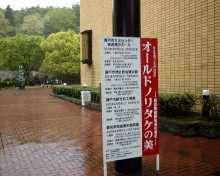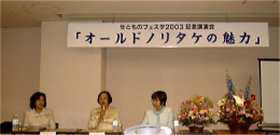Keeping in line with "Toso Festival" - festival thanking
a legendary person, Mr. Toshiro
Kato, for contribution to development of Seto pottery
industry in Kamakura era
(1200's) -, exhibition, "Beauty of Old Noritake -
History of prosperity of export ceramics"
is held at 4 exhibition area in Seto City as follows:
【Purport of Exhibition】
The mood of looking and evaluating again the proper value
of modern Japan ceramics
is growing now when 100 years have passed since
foundation of a company, Nihon
Toki The exhibition is to highlight "Old Noritake" for
re-estimate. "Old Noritake"
was produced by the best technology of potteries,
under-or over-glaze painters and
designers in Seto City and the other areas who played an
active part bold in
modernization and Westernization of those days. This
exhiibtin is to introduce the
magnificent beauty in such "Old
Noritake" with the collection by two
collectors
representing Japan mainly.
"Old Noritake" is
the general term of the Western style ceramics mainly
produced
for the U.S. by Nihon Toki Co. (Noritake
Co., Ltd. at present) which Morimura Brothers
Co. founded in 1876 in the period from the middle of
Meiji era(1886-1912) to the end
of World War II.
【Exhibition hall】
《Aprl 19 - June 22, 2003》
Fine art exhibition hall at Seto City Cultural Center
(See photo.) Admission fee \200.-
Seto City Folk Historical Material Museum
Admission fee \100.-
Seto Ceramics and Glass Art Center
free of
charge
《Aprl 19 - Aug. 31, 2003》
Aichi Prefectural Ceramic Muzeum Admission
fee \400.-
About 260 collections of Old
Noritake owned by collectors, Ms. Keiko
Wakabayashi and
Ms. Yumiko Oga are exhibited at 4 exhibition area with
each theme.
| Fine art exhibition hall at
Seto City Cultural Center |
 |
After hearing the memorial lecture meeting, "Charm
of Old Noritake" at the
conference
room in Seto City Cultural Center, I saw the collection
which overwhelmed me with so
absolutely gorgeous beauty.
| Discussion |
 |
【Lecturer】
Mr. Yuji Kawaguchi of Noritake Artist Club Co., Ltd.
Ms. Yoshie Itani of Orient Laboratory at Oxford
University
Ms. Keiko Wakabayashi, scholar of Old
Noritake
Ms. Yumiko Oga, scholar of Old
Noritake
【Point of lecture meeting】
Mr. Yuji Kawaguchi :
In 1883, Morimura Brothers, wholesaler ordered the
manufacture of coffee cup with
Mr. Masukichi Kawamoto of Seto. The coffee cup was the
one produced for the first
time in Japan. The designer of Morimura Brothers got the
hint from the dress of the
woman who went to a church or the others, and draw a
sketch. The sketch was sent
to Japan and was reflected precisely in the manufacture
of Old Noritake. Then, it
was exported to the U.S.A. and attracted the people
there.
The same production style are taken over to Noritake Co.,
Ltd. today.
In a world depression of the 1920s, a trend which desired
a gay thing was born. In this
trend, art deco was born. A new material such as aluminum
and plastic and the glazing
agent of Raster were also produced. Even if a new work is
produced, it would still take
much time to market it. Because, the corroboration which
could reproduce a perfect
work was required. (The part underlined is an
interpretation by this web page writer.)
Ms. Yoshie Itani:
In around 1880, the cupboard was united with liking of a
male and ornamented.
For example, it was ornamented with the beast etc. But,
man and woman's relation
changed and the ornament of a dining room changed led by
the woman. Meal culture
also became delicate. Riding on the current of the times,
the sales of Old Noritake
were
extended. (After that, beautifully delicate ceramics
stopped being in fashion as a picnic
and a barbecue were in fashion.)
In Europe, a rose is the Bush garden rose of the rose
pink color on botany. After Meiji
era, Japan also learned from this. Mr. Sataro Ishida of
the Morimura Brothers Co drew
the yellow rose as a motif. When going back in the past,
there was already a yellow rose
in the "Kasuga avatar picture scroll" and the
accessories of Koyasan in 1543 in Japan.
Then, the botanist introduced the yellow rose also in
Europe and the yellow rose became
known also among ordinary people.
There were 7,143 items in the export invoice from Japan
to the U.S. in 1897. Among
them, 4,692 items were ceramics. 2,681 items were
ceramics among 3,389 items in
1905 (Meiji 38). (Pottery was expressed as "fired
clay" and porcelain as "fired stone" in
English at that time.)
Mr. Cottler of Seattle acquired the doctor's degree by
research of "Transfer, Raster-
glazing , and a glazing agent" in Ohio State
University in 1970 paying attention to Old
Noritake. In order to take out touch "light has
shone" upon pottery, Meissen and royal
Copenhagen put white paints on the formed body→The
formed body becomes thick and
the whole lacks in balance.
On the other hand, the technique of the "removing
white" of Old Noritake
makes the
touch as if light hits a forming body, without using
white paints, and does not thicken
the forming body.
Ms. Yoshie Itani is submitting the doctoral dissertation
entitled "Export Porcelain from
Seto in the Meiji Era" to Oxford University. Perusal
of a doctoral dissertation is attained
in the National Diet Library of Japan.
Ms. Keiko Wakabayashi:
The "Cobalt-Gold Glazing Tea Set" seen in the
warehouse of the parents' home in
Nagoya in girlhood was the first encounter with Old Noritake. Then, I knew from
the
back mark that it was Old Noritake
manufactured for the British export by Nihon Toki
in around 1908 (Meiji 41). Since then, I have collected Old Noritake with the deceased
husband for about ten years.
There is a work of the similar Gold-Glaze or the
Gold-Point-Heaping in Westwedgehdd
in Europe., but it is produce by a process which makes
"Okoshimono" (or Japanese
steamed rice cake). On the other hand, all Old Noritake is drawn and created
by hand,
and so a craftsman's technology and the heart are
reflected in a work. I performed the
Old Noritake exhibition in
October, 2002 jointly with the private art museum
"the Okura
-Shuko-Kan" in Hotel Okura of Tokyo. Noh costumes of
the Edo era were offered from
the Okura -Shuko-Kan, and Old
Noritake of the Meiji era from Mr. Wakabayash. The
both were put in order and exhibited. Each exhibit does
not have sense of incongruity
and is harmonized very much. I am happy that longtime
dream of "Holding Old Noritake
exhibition in art museums all over the country, and
having you to know the beauty of
Old Noritake or the
technique and passion of predecessors" is being
realized.
Ms. Yumiko Oga:
After seeing the bowl of the golden heap of six square
shapes put on the Western
tableware shelf of the antique mall of the State of
Maryland in the U.S., I began collection
of Old Noritake. I was
charmed by delicate beauty, such as a color with the
transparent
feeling to which the cobalt color is mixed with purple,
and a color which inclines to shade.
When seeing the back mark of the bowl, a character of
Japan and a maple leaf was
drawn. When investigating the meaning at a library, I
found that the stamp had pointed
out "Made byMorimura Brothers Co. in 1891." I
went back temporarily, looked at the
book of "Old Noritake"
got from the friend, and could confirm it. I was
impressed by
there being a company which has manufactured and exported
the porcelain which can
be called such a wonderful work of art in Japan of the
Meiji era. I was overwhelmed by
the abundance of the expression and the height of
completeness which have taken in
the aesthetic sense of the Japanese of the Meiji era and
the technique similar to the
shading off of the yuzen of a kimono.
|

